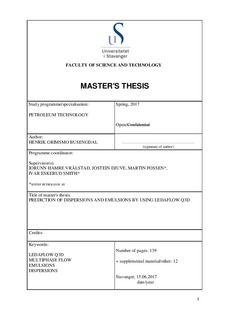| dc.description.abstract | Well streams in pipelines are often transported over relatively long distances.
The well streams often consist of simultaneous flow of gas, oil and water. Oil and water affect each other by making emulsions, which influence on the fluid properties of the fluid mixture, and further has an impact on flow properties like pressure loss, water holdup and flow regimes. Accurate knowledge of the flow behaviour in a pipeline is crucial to design and optimize production, transportation and processing facilities. The correct design of a pipeline can result in extended lifetime for the oil field, higher economic profitability and optimized production rate.
To extend the knowledge of the well fluids behaviour, there are several experimental techniques available. One is the conventional flow loops, at SINTEF Petroleum laboratories at Tiller, Trondheim. They are accurate testing devices. However, the problem with these flow loops are that they can only test the fluid behaviour inside a pipeline of a certain length. For this reason, SINTEF Petroleum also use the wheel flow simulator, which is a rotating wheel, where the fluids inside “see” an endless pipe through which they flow as a multiphase mixture.
Computer programs simulating the fluid flow, is also an available experimental method to consider. LedaFlow Q3D is a computer program developed by SINTEF, for the purpose to simulate the multiphase fluid mixture in more detail. A special version of LedaFlow Q3D is also available, specially designed to simulate the wheel flow.
The research questions are based on how the input parameters in LedaFlow Q3D affect the simulation results. Will it be possible to tune specific simulations to match the results (output of torque) produced from experiments with the wheel flow simulator? Will it be possible to create a blueprint of which input parameters to use for various systems in future simulation work, to match the simulation results with the results produced from experiments with the wheel flow simulator?
The simulation work in LedaFlow Q3D will be based on the fluid system from one particular wheel flow experiment, conducted by SINTEF at Tiller, in Trondheim.
The fluid system contains 60 % nitrogen, 30 % water (tap water), and 10 % oil (Exxsol D80) by volumes. The initial temperature and pressure was 25 °C and 1 bar. The tested profile of the wheel experiment was a stepwise velocity scan from 0.1 m/s to 2 m/s. However, when simulating in LedaFlow in this thesis, the focus will be on a wheel velocity of 2 m/s, which gave an output of torque equal to approximately 4.5 Nm.
Multiple simulations have been conducted, by systematically adjusting several input parameters. The effect of the input parameters on the simulation results has been investigated, and the acquired knowledge have been used in attempts to tune the simulation cases to match the results produced from experiments with the wheel flow simulator. Some of the simulations was successfully tuned to match with the results from the wheel flow experiment (torque = 4.5 Nm), for a wheel velocity of 2 m/s. However, by using the same input parameters to tune simulations with a wheel velocity of 1 m/s, the simulations failed to match with the results from the wheel flow experiment. These results indicate that it is difficult to create a blueprint for the input parameters. Although some input parameters successfully manage to tune specific simulations to match with the wheel flow experiment, they may not work for various velocities or systems. | nb_NO |

